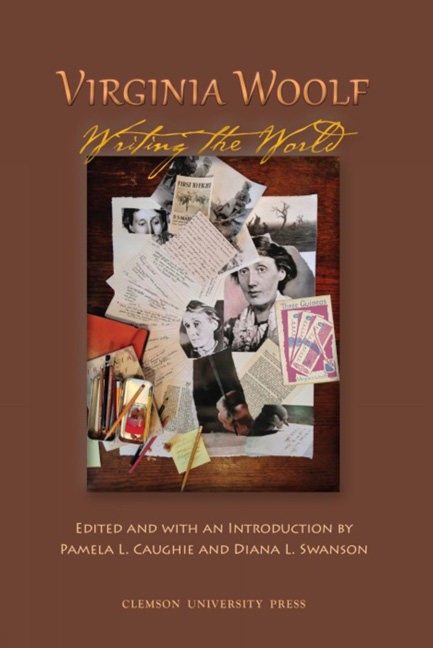Book contents
- Frontmatter
- Table of Contents
- Introduction
- Acknowledgmen
- Abbreviation
- WAR AND PEACE
- Roundtable: Woolf and Violence
- Intersections: Surveillance, Propaganda, and Just War
- Modernism and Memorials: Virginia Woolf and Christopher Isherwood
- Taking Up Her Pen for World Peace: Virginia Woolf, Feminist Pacifist. Or Not?
- The Sex War and the Great War: Woolf's Late Victorian Inheritance in Three Guineas
- Sky Haunting: The British Motor-Car Industry and the World Wars
- The 1914 “Expurgated Chunk”: The Great War in and out of The Years
- “beauty, simplicity and peace”: Faithful Pacifism, Activist Writing, and The Years
- Virginia Woolf, Katharine Burdekin, and Britain's Cosmopolitan Musical Culture
- Death in the Air: Virginia Woolf and Sylvia Townsend Warner in World War II
- WORLD WRITER(S)
- ANIMAL AND NATURAL WORLD
- WRITING AND WORLDMAKING
- Notes on Contributors
- Conference Program
- Appendix: Virginia Woolf Conference Exhibit Items, Newberry Library
Modernism and Memorials: Virginia Woolf and Christopher Isherwood
from WAR AND PEACE
- Frontmatter
- Table of Contents
- Introduction
- Acknowledgmen
- Abbreviation
- WAR AND PEACE
- Roundtable: Woolf and Violence
- Intersections: Surveillance, Propaganda, and Just War
- Modernism and Memorials: Virginia Woolf and Christopher Isherwood
- Taking Up Her Pen for World Peace: Virginia Woolf, Feminist Pacifist. Or Not?
- The Sex War and the Great War: Woolf's Late Victorian Inheritance in Three Guineas
- Sky Haunting: The British Motor-Car Industry and the World Wars
- The 1914 “Expurgated Chunk”: The Great War in and out of The Years
- “beauty, simplicity and peace”: Faithful Pacifism, Activist Writing, and The Years
- Virginia Woolf, Katharine Burdekin, and Britain's Cosmopolitan Musical Culture
- Death in the Air: Virginia Woolf and Sylvia Townsend Warner in World War II
- WORLD WRITER(S)
- ANIMAL AND NATURAL WORLD
- WRITING AND WORLDMAKING
- Notes on Contributors
- Conference Program
- Appendix: Virginia Woolf Conference Exhibit Items, Newberry Library
Summary
Scholarly narratives that define modernist fiction traditionally position Victorian Age-born innovators of the novel against those with whom they share the realm of literature and letters during the interwar years. On one hand, there are veteran soldiers-cum-authors emerging ten years after the Armistice; on the other hand, there are Younger Generation writers born in the first years of the twentieth century, writing in the wake of war and modernism, too young to have participated in either. Veteran authors occupy a privileged position in this critical discourse: they may or may not be modernist since, as Jay Winter has convincingly argued, their primary impetus is the “aesthetics of direct experience” (2). Consequently, what remains when scholars assess the literary landscape of the interwar years are two seemingly distinct groups of writers, commonly characterized as antagonists: the aging modernists and the thirtysomething Younger Generation writers. Although studies such as A Shrinking Island (2004) and Intermodernism (2009) do shed new light on this literary interwar landscape, they trend in two directions: they either chart modernism's evolution in the 1930s privileging the work of canonical modernists (Jed Esty) or create new categories to characterize literature produced by those too young—or too political or too female—to be modernist (Kristin Bluemel). Ultimately, both approaches participate in an antagonistic discourse situating modernist writers in opposition to their Younger Generation counterparts despite the literary-historical reality that both groups are responding to the consequences of the Great War by testing the efficacy of fiction in a postwar world.
My essay complicates the dominant literary-historical narrative by comparing Virginia Woolf's Jacob's Room (1922) and To the Lighthouse (1927) with Christopher Isherwood's The Memorial (1932) in the context of the Great War and the national memorialization in its wake. (Woolf's essay “The Leaning Tower” [1940] will help me tie the threads together.) Such a constellation advocates for a discourse of affiliation highlighting the shared literary sympathies of modernist and Younger Generation writers in a world saturated by memorials both military and masculine.
MODERNISM AS WAR MEMORIAL
One of the most convincing characterizations of modernism is as a response to the Great War.
- Type
- Chapter
- Information
- Virginia Woolf: Writing the World , pp. 30 - 36Publisher: Liverpool University PressPrint publication year: 2015



